|
|
|
Sort Order |
|
|
|
Items / Page
|
|
|
|
|
|
|
| Srl | Item |
| 1 |
ID:
121825
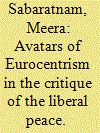

|
|
|
|
|
| Publication |
2013.
|
| Summary/Abstract |
Recent scholarly critiques of the so-called liberal peace raise important political and ethical challenges to practices of postwar intervention in the global South. However, their conceptual and analytic approaches have tended to reproduce rather than challenge the intellectual Eurocentrism underpinning the liberal peace. Eurocentric features of the critiques include the methodological bypassing of target subjects in research, the analytic bypassing of subjects through frameworks of governmentality, the assumed ontological split between the 'liberal' and the 'local', and a nostalgia for the liberal subject and the liberal social contract as alternative bases for politics. These collectively produce a 'paradox of liberalism' that sees the liberal peace as oppressive but also the only true source of emancipation. However, the article suggests that a repoliticization of colonial difference offers an alternative 'decolonizing' approach to critical analysis through repositioning the analytic gaze. Three alternative research strategies for critical analysis are briefly developed.
|
|
|
|
|
|
|
|
|
|
|
|
|
|
|
|
| 2 |
ID:
121821
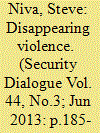

|
|
|
|
|
| Publication |
2013.
|
| Summary/Abstract |
In the twilight of the USA's ground wars in Iraq and Afghanistan, there has been an expanding shadow war of targeted killings and drone strikes outside conventional war zones, where violence is largely disappeared from media coverage and political accountability. While many attribute the growth in these shadowy operations to the use of new technologies and platforms such as drones, this article argues that the central transformation enabling these operations is the increasing emergence of network forms of organization within and across the US military and related agencies after 2001. Drawing upon evidence from unclassified reports, academic studies, and the work of investigative journalists, this article will show that elements within the US military and related agencies developed in the decade after 2001 a form of shadow warfare in which hybrid blends of hierarchies and networks combine through common information and self-synchronization to mount strike operations across transnational battle spaces. But, rather than a top-down transformation towards networks, this article will show how it was the evolution of the Joint Special Operations Command (JSOC) from an elite strike force into a largely autonomous networked command that has been central to this process. Although drone strikes have received the bulk of critical attention in relation to this expanding shadow war of targeted killing, this often-lethal networked warfare increasingly resembles a global and possibly permanent policing operation in which targeted operations are used to manage populations and threats in lieu of addressing the social and political problems that produce the threats in the first place.
|
|
|
|
|
|
|
|
|
|
|
|
|
|
|
|
| 3 |
ID:
121822
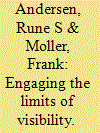

|
|
|
|
|
| Publication |
2013.
|
| Summary/Abstract |
In this article, we introduce selected photographs in order to engage with their capability for questioning the representational codes dominant in the visualization of security policy and surveillance. We argue that the intangible, abstract workings of state power in connection with security, surveillance and current forms of warfare can aptly be represented and challenged by means of photography. By engaging the limits of visibility, the selected photographs explore the limits of photojournalism and security alike. First, they operate by making visible what is normally invisible, though they also blur the boundaries of the seen and the unseen. Second, they function outside the discursive-representational regime within which photojournalism, based on a powerful tradition, operates, and within which media and security professionals visualize security. By so doing, they avoid involuntary incorporation into and support of this very regime that simultaneously they help understand. Third, they visualize structures and institutions rather than people, thus avoiding ethical dilemmas in connection with representations of people in pain. Discussing selected photographs by Trevor Paglen and Simon Norfolk, we show what these photographs do to alter the discursive frame within which the politics of security is understood. Such alteration facilitates understanding of the extent to which current societies are penetrated by the ideas and practices of security and surveillance, and furthers investigation of the discursive structures that enable such penetration.
|
|
|
|
|
|
|
|
|
|
|
|
|
|
|
|
| 4 |
ID:
121823
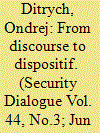

|
|
|
|
|
| Publication |
2013.
|
| Summary/Abstract |
This article is a historical study of how states have articulated statements about terrorism since the 1930s; under what conditions these statements have been articulated; and what effects the discourses made up of these statements have had on global politics. This includes the constitutive role of the present discourse on what is posited as a terrorism dispositif. The inquiry is inspired by Foucault's historical method, and comprises the descriptive archaeological analytic focused on the order of the discourse (including basic discourses in which the terrorist subject is constituted) and the genealogical power analysis of external conditions of emergence and variation of discursive series, whose treatment benefits also from Carl Schmitt's concept of the nomos.
|
|
|
|
|
|
|
|
|
|
|
|
|
|
|
|
| 5 |
ID:
121824
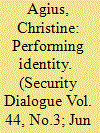

|
|
|
|
|
| Publication |
2013.
|
| Summary/Abstract |
The Danish cartoon crisis, which attracted international media attention in 2006, has largely been debated as an issue of freedom of speech, feeding into broader debates about the 'clash of civilizations'. This article aims to explore the dominant discourses that performed a seemingly stable and consistent Danish identity at the domestic and external levels. Domestically, the discourse of a progressive Danish identity under threat from unmodern others was performed via discourses of a 'culture struggle' and a restrictive immigration policy designed to keep intact a narrow definition of Danishness. Externally, Danish identity and security was performed and defended via participation in the 'war on terror', democracy promotion and overseas development assistance, which became tools that were not simply associated with security in the liberal sense but also contained a spatial dimension designed to keep consistent the image of the complete nation-state. By adopting a discursive approach, the article aims to explore the performance of Danish identity that animated the cartoon crisis in order to highlight the complexities and contestations that animate ideas of self.
|
|
|
|
|
|
|
|
|
|
|
|
|
|
|
|
|
|
|
|
|